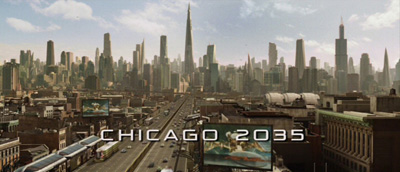Rendered Chicago
The city of Chicago envisioned by Alex Proyas in the movie I, Robot is set almost as many years in the future as I have been alive. Either I’m underestimating the last three decades of technological progress or Proyas is being too optimistic about how quickly his vision could be reality, but in either case the movie is an enjoyable one, teasing a pretty decent narrative out of a collection of loosely connected short stories and novels by Isaac Asimov. I especially enjoyed the film’s elaborate CG environments that create a clearly futuristic but also recognizable cityscape. (They had to, the movie was shot in Canada.) I’ve read that Proyas set the movie when and where he did because he liked the way the Chicago of today juxtaposes old and new architecture so comfortably and thoroughly. Of course, I agree, and for the most part the movie does a great job taking this trend into the future. I was intrigued by the choices the virtual urban planners made in removing and inserting new structures into the skyline. (And if you are too, you’ll want to visit the Art Institutes’s excellent 10 Visions exhibit.)
I’ve created a Flickr gallery of screenshots from almost all the scenes of Chicago in the movie. It is pretty clear where the designers placed the U.S. Robotics HQ building, but studying the images shows that they weren’t overly concerned with keeping it in the same place throughout the movie. A few things are clear from these shots:
- By 2035 Mayor Daley is dead because he isn’t in office because if he was he’d never allow a plaza like the one in the movie without a single flower bed or row of trees.
- The architect of 71 S. Wacker will be hired by USR to build their tower. His client’s only instruction: “make it taller.”
- Yes, we have sentient machines taking care of us, but was it worth it to give up recreational boating on the river?
- The L is way too silent and slinky. I can believe in robots with positronic brains, OK, but it simply defies belief that the CTA will ever get their act together for the effort required to replace the current clunky rolling stock (nor would I want them to, come to think of it).
These images raise a bunch of questions, some of which I’ve posed in the screenshot annotations and descriptions. Feel free to comment!















I am very impressed with your site! It is full of interesting content. Keep up the good work.